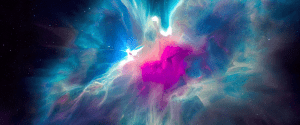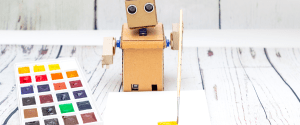The rise of the machines: How AI can make creatives more…creative
Stephen Hawking famously said: “Success in creating effective AI could be the biggest event in the history of our civilisation. Or the worst. We just don’t know. So we cannot know if we will be infinitely helped by AI, or ignored by it and side-lined, or conceivably destroyed by it.”
So perhaps it’s not surprising that many in the creative industries have been looking over their shoulders a little fearfully. But then, technological disruption has always come with a good dose of doomsaying. (Job losses! Homogenisation of ideas! Clients doing it for themselves!)
But now we’re experiencing AI for ourselves every day, it’s clear it’s becoming an amazing complement to what we do. Rather than replacing human prowess, it’s enhancing it.
As AI does the granular work of processing vast amounts of data and researching market patterns across sectors and regions, so the value of the human experience, of making, feeling and imagining – of asking ‘why’ – is increasing.
Which can only be good for creatives. There’s more room for novel ideas and building bigger, better things. Much like when Adobe rocked our world back in the early 90s, we’re starting to absorb the tech and use it to shape what we do, not vice versa.
So why should more designers embrace this phenomenon and add it to their toolkits?
It can cut back on tedious aspects of the job, freeing us to develop more meaningful relationships with clients.
Designers are faced with lots of backend day-to-day tasks, such as product localisation and creating the same graphics in multiple languages. At bluemarlin, we’re finding AI is able to pick up a lot of the slack, meaning our designers can focus on the things they’re good at.
In the world of brand design, that means spending more time communicating with colleagues and clients, exploring consumer needs and responding with innovative ideas. It means ensuring a brand lives in the head, heart and mind of the consumer.

What we do is so much more than a collection of lines, colours and pixels on a screen. It’s about emotional exploration, expression and connection. While AI might be able to mimic a final outcome, it can’t replace the unique journey a creative professional experiences with a client.
AI gives us speedy design prototyping. Enter basic sketches with a few parameters and it can deliver a quick render or prototype.
Many of the initial benefits of any tech advancement focus on optimisation and speed. We’re able to design faster because of the increased efficiency that AI offers.
AI can analyse vast amounts of data and make the path to design adjustments more useful and laser-focused. A designer can then pick and approve their work based on that data. The most effective designs can be created expediently and multiple prototypes can then be appraised with clients.
Far from homogenising work, it makes creatives less reliant on existing pools of resources, leading to samey work appearing all over the place.
We’re already experiencing a ‘trend to sameness’ throughout the creative industries thanks to a democratisation of tools and resources. And as digital efficacy has become a major priority, it’s got even worse. Think of luxury fashion logos. Burberry, Saint Laurent, Balenciaga, Balmain all started to look and feel the same – so much so that Burberry recently underwent a logo refresh.
And how many times have you seen the same stock images pop up on websites and throughout brand communications? AI is allowing us to focus on craftmanship – something that every designer I know cares about (and AI skips over).

AI means we can spend time avoiding the predictable and find unique sources of inspiration. Think about the distinctive perspectives you can offer. What are your personal ideas and tastes? Can you merge hobbies or other interests with your creative work?
It’s not cheating! It gives us headspace to push boundaries and create better work.
AI is a tool. It doesn’t have consciousness or awareness. It makes no creative judgments – it does, however, respond to the intent of the operator. So it’s up to the designer to guide the AI.
As AI tools provide a new way to explore ideas, we’re finding them an incredibly rich source of inspiration – and of course there will be more advantages to come.
It will showcase real talent and mean creative people’s efforts are really appreciated – making for a more rewarding work environment.
Most technological advancements improve efficiency, mimicking human behaviour to carry out repetitive, high-volume tasks, so we can work on high-level, more valuable stuff, such as strategic planning, research and development. AI is raising the bar and making our jobs more about what innovates, excites and pushes the agenda.

These are exciting times for designers. Those that are still looking over their shoulders should rest assured. AI will never be conscious, or capable of the spontaneous leftfield thoughts that make our hearts beat. And that’s because it doesn’t experience those flashes of inspiration that can change a project’s direction on a dime.
While there’s still an appetite for inspired thinking, for bursts of madness and the bizarre, there’ll always be space for us. AI is simply going to make our lives a whole lot more exciting – so start thinking of it as a collaborator, not a competitor, and enjoy the ride.
To continue the conversation, please feel free to email our Design Director, Gareth Roberts on garethroberts@bluemarlinbd.com
